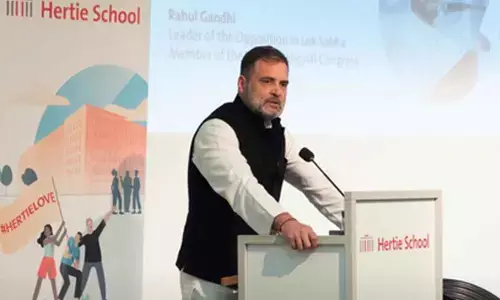Neglecting the value of uniform education system

Neglecting the value of uniform education system
Education is one of the essential components in Human Development Index (HDI). The Cabinet approved new Education Policy-2020 (NEP) has its own positive and negative implications on the socio-economic and human development of the country.
Education is one of the essential components in Human Development Index (HDI). The Cabinet approved new Education Policy-2020 (NEP) has its own positive and negative implications on the socio-economic and human development of the country. From the past 35 years the educational policy regime in India has been stagnated and given least priority. The present new National Education Policy-2020 intended to introduce several key changes in overall structure and procedure of the education system i.e., school education as well as in the higher education system in India.
At present the educational sector in the country is facing two major challenges one is accessibility of quality education (School and Higher education) in the country. And second is existence of disparities or inequalities in both school and higher education in the country. After thorough examination of the NEP 66 pages document it has been realised that the NEP has ignored the above mentioned two major challenges of the education sector in India. Its more emphasis was on building future generations by ignoring the issues of present generation education system.
As of now, educational system in India can be seen into two phases i.e., school education and higher education. The most triggered challenge of the educational system in the country is persisting disparities in both school and higher education. Disparities or inequalities in terms of nature of educational institutions (State and Central), even in the central schools Navodaya, Model Schools, Kendriya Vidyalaya, Railway Schools, Kasturba Gandhi schools, etc., in terms language (English versus other regional languages and national language Hindi), in terms of curriculum / syllabus (State and Central), in terms of location of educational institution (Urban versus Rural), in terms of nature of the institutional ownership (Private and Public institutions) etc., are some of the disparities hampering the quality education in the country. In this context, the proposed NEP-2020 has no provision to address these disparities and it also neglected the importance of uniform educational system across the country in order to achieve the objectives of the education.
Medium of instruction
For a long time, there has been an ambiguity over the medium of language in the country. Regional language versus national language, still Hindi is the predominant language over regional language especially in north India. Paradoxically, the government projects English as colonial language and still accepts the importance of global language.
The vaguest aspect in the new NEP is teaching up to fifth standard in mother tongue. Sometimes, such cases in which the children of the inter-state migrants' or transferable job holder's mother tongue is different from the state where the family is staying which may leading confusion to the both parents and institutions too. Learning a new language (English) right from the beginning of childhood days onwards becomes easier than reaching up to 5th standard. The best example in this context is, in most of the states the performance of the private English medium school students' are best in comparison with the government school students with regional languages.
At this juncture, it is worthwhile to mention the opinion of the Raja Ram Mohan Roy, the veteran social reformer of India who strongly criticised the Indian traditional literature and languages which largely hinders the nation's future generation to achieve modern life. Therefore, he suggested in place of Indian traditional literature and language it should be necessary to adopt a modern educational system with western features especially, English language and curriculum.
Later he founded an Anglo-Hindu School and College in Bengal with English as a medium of instruction. Similarly, the Muslim social reformer Sir Sayad Ahmed Khan loyalist of loyal to the British government appealed to his Muslim community to learn English education so that the Muslim community will be civilised. Thereafter, he founded Muhammadan Anglo- Oriental School and College in 1883 English as a medium of language later it became the Aligarh Muslim University.
School education
Strengthening of existing educational institutes by providing more financial resources to develop infrastructure and quality teachers, etc., are more important and viable solution to transform present educational system to reach the global standards. But the present NEP has intended to restructure the whole school education without having any research or baseline survey on present school educational system.
The primary change in NEP-2020 is inclusion of pre-school education into school education system. At present the pre-school education system can be finding in two types one is run by Angunwadi Centres under ICDS project without proper facilities and the second is the majority of the pre-schools are run by the private schools known as Nursery, UKG and LKG. The policy could not mention about these existing situation and problems associated with the pre-school system at the ground reality.
Moreover it proposing a new Early Childhood Care and Education (ECCE) system assuming flexible, multi-faceted, multi-level, play based, inquiry based, learning . Instead of these it would have been done a more focussed research on the practical challenges in early childhood learning process.
Vocational education
Children up to certain age need proper foundation in education than the vocational skills. Even if they fully skilled they may not be allowed to work up to completing certain educational qualification. The new NEP proposed vocational education is not a new concept but it is already there in practice across the country as vocational colleges, ITIs and Polytechnic colleges etc,. Most of these institutions are in a declining stage largely suffering from lack of funds, faculty and infrastructure etc,.
Higher education
In the part Two of the NEP Section-9.1, which highlighting "the importance of higher education in promoting human well being and societal well being as envisioned in the constitution –a democratic, just, socially conscious Cultured and human nation upholding liberty, equality, fraternity and justice for all". The paragraph in NEP document ignored and drops down the important characteristic feature of the Indian constitution i.e.,"Secular" which is also the part of"Basic Structure" of the Indian constitution as defined by the Supreme Court of India in its land mark judgement Kesavananda Barti V. State of Kerala in 1973. It also further holds that the Parliament cannot amend this basic structure of the Indian Constitution. By excluding this important feature in the policy document,the government has omitted the importance of developing communal harmony among the young educated citizens of India.
Four- year degree
Four year degree program under NEP with multiple exit options, the new proposition in NEP method seems to be more attractive but not feasible to the career and job situation in Indian society. Presently, there are number of unemployed graduates in the society with professional and non-professional degree. Unfortunately, the government and industry has not been able to provide job opportunities to the full degree holders then how come it could be possible to accommodate the certificate, diploma holders can be expected to get a suitable job, remuneration or salary after exiting before completion of the degree program. Private sector can also easily exploit the services of this type of degree holders.
Multi- disciplinary
Multi-disciplinary approaches in higher education is not a new concept in NEP, it has been there in higher education. However allowing too much flexibility in choosing multiple specialisations may lead missing focus on main discipline or subject. There may be a possibility in selecting irrelevant subject combinations in an over-enthusiastic manner or lack of proper understanding on subject allied subject combinations.
Monitoring institutions
To dismantle the monitoring bodies of UGC and AICTE, there should be a reasonable cause for replacing nation level bodies. There should be a proper research before repealing such an apex bodies with long run experience in monitoring and evaluation of these governing bodies. The immediate problem with the higher educational institutions in the country is political intervention and curbing the autonomy of the both the higher educational institutions as well as monitoring agencies.
Conclusion
On paper this NEP-2020 seems to be more attractive than the previous education policies, however the success of the NEP is largely depends on the implementation at the ground level. The new education policy is expected to meet the challenges and gaps existing in present educational system in the country. Since, education fall under the concurrent list, the states' cooperation and coordination is required for the successful implementation of the NEP. Therefore, instead of formulating unilateral policies on key subjects like education, the central government would have been consider the critical policy inputs, deliverables along with the triggered challenges, gaps in the present educational system at the gross root level, including the view points of the state governments.
In order to achieve the expected Sustainable development the fourth goal of United Nations, the government need to introduce several provisions into the NEP. Since 90 per cent of schools and educational institutions are under control of the states, the centre needs to bear the proportionate cost sharing of the expenditure. Moreover it needs to spend at least 10 per cent GDP on education to increase the Gross Enrolment Ratio (GER) as expected in the NEP. Further it is also important to strict implementation of the Right to Education Act especially in the private educational institutions, allocation of 25% of seats for the poor and marginalised sections in order to attain the social justice.
(The author is former Dean,
Faculty of Social Sciences,
Osmania University, Hyderabad.)



















